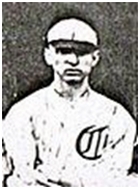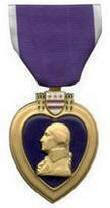This page sponsored by Mark Haubenstein, founder of findmymedals.com, a website dedicated to helping veterans and their families research, recover or replace war medals. Mark is also a freelance writer and has written for "America in WW II" magazine. He resides in San Jose, CA.
Eddie Moore
| Date and Place of Birth: | March 8, 1894 New Bloomfield, PA |
| Date and Place of Death: | September 30, 1918 Verdun Sector, Argonne Forest, France |
| Baseball Experience: | Minor League |
| Position: | Catcher |
| Rank: | Second Lieutenant |
| Military Unit: | Company D, 39th Infantry Regiment, 4th Division AEF |
| Area Served: | France |
At the close of the nineteenth century, it would be hard to find a
more likable and respected family in New Bloomfield, Pennsylvania, than
Eddie Moore’s. Eddie’s paternal grandmother, Annie E. Moore, was
described as being a devout Presbyterian and having a disposition that
was “bright and cheerful, with always a kind word for those about her”.
Her husband, Robert A. Moore, was deemed “devoted to his wife” and
“affectionate”. [1] Eddie’s father, Edward E. Moore, was a respected
physician with a large, county-wide practice. In addition to his
practice, he was the county prison doctor and physician to the students
at the Carson Long Military Academy. Dr. Moore was often “on-the-go, day
and night”, and “always gave more than he received”. [2] Clara Lahr
Moore, Eddie’s mother, was also widely admired. A member of the local
high-society, she was noted as being very “cultured and learned”. [3]
Being from such a fine pedigree, Eddie Moore himself would be remembered
for being “well known in his home town”, and for being “very popular
with the younger set”, and being of “a cheerful disposition”. [4] Much
would be expected of Eddie and he would make the ultimate sacrifice for
not only his family and community, but for his country as well.
Edward Lahr Moore was born on March 8, 1894. He attended both New
Bloomfield High School and the previously noted Carson Long Military
Academy. Through his formative years, Eddie had developed into one of
the better athletes in all of Perry County. His sport of choice was
baseball of course, and he often found himself competing against players
several years his senior. Despite the talent he possessed, a baseball
future wasn’t deemed an appropriate long term proposition, especially
for a young man from such a notable family as the Moore’s. Fully
planning and expecting a military career, Eddie earned an appointment to
the prestigious West Point Military Academy in June of 1912, and he
entered classes in the coming fall. Unfortunately, after completing the
annual mid-term exams in late December, Eddie was discharged from the
Academy on January 13, 1913, for “deficiency in English”. [5] Although
greatly disappointed (and perhaps a bit embarrassed), Eddie returned
home to New Bloomfield, determined more than ever to find his way in the
world. As we would later learn, the army would still have a strong pull
on his future, and Eddie would eventually find his way back to a
military life.
In 1914, Eddie enrolled at the State College, now known as Penn State
University. He didn’t declare a major of study, but he did join the
baseball team, serving as their stalwart catcher for one season. He
played so well in fact, that several local teams vied for his services
after the college season was over.
Earlier in 1914, plans had been underway to try and form a professional
baseball league featuring teams that lined the Blue Ridge Mountains,
from Western Maryland, South Central Pennsylvania, and the Panhandle of
West Virginia. At its inception, the Blue Ridge League was a Class D
league, the lowest level professional league at the time. The six teams
had no formal ties to any major league club, however, the Philadelphia
A’s and Washington Senators were known to have sent some players to fill
out rosters. This “free agent” league brought new excitement to the
region, and served as a relaxing diversion from the threat of war that
was now brewing over in Europe. Most players earned $50 a month, but
star players could earn up to $125 a month (although it was known that a
few professional teams, most notably the Senators, were paying some
players additional dollars under the table).
After his successful year at Penn State, Eddie knocked around with
several semi-pro teams, but eventually joined the local representative
of the Blue Ridge League, the Chambersburg (Pennsylvania) Maroons, for
the start of the 1915 season. Managed by former big leaguer Gus Dorner,
the team played its home games at Wolf Field which was known as a
pitcher’s paradise as only one home run was hit at the park the entire
year. Eddie was the catcher on the team that finished a woeful 28 – 51.
Although the records that were kept were not always complete, the
numbers compiled on Eddie where as follows: 42 games played; 136
at-bats; 29 hits; 2 doubles, and a .213 batting average. This was to be
his only year of pro ball.
In September of 1916, Eddie decided he still wanted a military career,
and he voluntarily enlisted as a private in the U.S. Army. Originally he
was sent to Fort Slocum, New York, but a few days later he was quickly
sent to duty on the Mexican border. There, Eddie was one of 10,000 U.S.
soldiers who served under the command of Brigadier General John J.
Pershing in pursuit of the Mexican bandit, Pancho Villa. In May, 1917,
his regiment was transferred to the mobilization camp at Syracuse, New
York, and while there, Eddie was transferred to the 47th Regiment
Headquarters Company. On January 4, 1918, he was sent to Reserve
Officers Training Camp at Fort Oglethorpe, GA, from which he graduated
in April as an official cadet. He rejoined his regiment at the
embarkation camp at Camp Mills, New York, and left for France on April
30, 1918. Upon arriving in France, Eddie asked to be assigned to field
duty and his request was granted. He was sent to a gun company and he
received his commission as a second lieutenant on August 3, 1918, when
he was transferred to Company D of the 39th Infantry Regiment. [6] He
was assigned as the battalion’s adjutant (Personnel Officer), just as
his unit prepared for the final offensive of the war known as the
Meuse-Argonne Offensive.
Meuse-Argonne was the final Allied push against the Germans on the
western front. Spanning September 26 to the end of the war on November
11, 1918, the fighting was fierce. Early on, German resistance was, at
times, overwhelming. Massive artillery bombardment and machine gun fire
kept the Allied advancement at bay for days at a time. Compounding
Allied movement was a low valley with the thick, hilly Argonne forest on
one side, and the Meuse River on the other. This terrain made excellent
defensive positions for the five German divisions guarding their
homeland. The weather played a key factor, too. Constant rain filled
shell holes with water. Even in the dense forest, dirt turned to thick
mud. The roads morphed into sticky goo which prevented supplies from
being moved forward and impeded the evacuation of the wounded. It wasn’t
until October 13, that headway was finally made for the sluggish, yet
determined British, French and American troops.
Sadly, Eddie Moore died early in the Meuse-Argonne campaign on September
30, 1918. He was twenty four years old. How he died is unknown, although
up to seventy percent of all fatalities in the Great War were from
artillery fire. Many sources list him as KIA, but local records show him
as wounded in battle on September 28, and dying of his wounds in
Evacuation Hospital #4 on September 30. [7] It would be just over three
months before Eddie’s family was finally notified of his death. His body
would never be returned to U.S. soil.
For giving his life in service to his country, Eddie Moore was awarded
the Purple Heart, the World War I Victory Medal, with the Meuse-Argonne
Battle Clasp, as well as the Mexican Border Service Medal. His remains
are buried with other fallen comrades in the Meuse-Argonne American
Cemetery in Romagne, France, Plot B, Row 8, Grave 31. In addition, Eddie
is still honored today on the New Bloomfield, Pennsylvania, World War I
Memorial. His name is inscribed on a tablet that honors the 62 citizens
who left “New Bloomfield and Centre Township to promote world freedom
and to preserve the safety and honor of their country”. [8]
© Mark Haubenstein, March, 2012 (permission of use granted).
[1] Morning Tribune, Altoona PA, January 31, 1891
[2] “Dr Edward Everett Moore”, Bill Corl, Findagrave.com
[3] “History of Perry County, Pennsylvania”, Harry Harrison Hain, 1922
(Page 10)
[4] Altoona Tribune, Altoona PA, January 11, 1919 (Page 11)
[5] “Official Register of the Officers and Cadets”, United States
Military Academy, 1913 (Pages 23, 24)
[6] “Penn State in the World War”, Alumni Association of the
Pennsylvania State College, 1921 (Page 367)
[7] “History of Perry County, Pennsylvania”, Harry Harrison Hain, 1922
(Page 590)
[8] HMdb.org (Historical Marker Database)
“Meuse-Argonne Battle”, Capt. Arthur E. Hartzell, 1919
“The Fourth Division: It’s Services and Achievements in The Great War”,
Col. C. A. Bach and Henry N. Hall, 1920
Pittsburgh Post-Gazette, Pittsburgh, PA, January 4, 1919
BlueRidgeLeague.org
Baseball-Reference.com
Date Added: March 9, 2012
Baseball's Greatest Sacrifice is associated with Baseball Almanac
Baseball's Greatest Sacrifice is proud to be sponsored by


